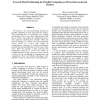Free Online Productivity Tools
i2Speak
i2Symbol
i2OCR
iTex2Img
iWeb2Print
iWeb2Shot
i2Type
iPdf2Split
iPdf2Merge
i2Bopomofo
i2Arabic
i2Style
i2Image
i2PDF
iLatex2Rtf
Sci2ools
ISPDC
2007
IEEE
2007
IEEE
Towards Data Partitioning for Parallel Computing on Three Interconnected Clusters
We present a new data partitioning strategy for parallel computing on three interconnected clusters. This partitioning has two advantages over existing partitionings. First it can reduce communication time due to a lower total volume of communication and a more efficient communication schedule. When the network topology is a linear array this partitioning always results in a lower total volume of communication compared to existing partitionings, provided the most powerful node is at the center of the array. When the topology is fully connected this partitioning results in a lower total volume of communication for all but a few power ratios. Second, it allows for the overlapping of communication and computation. These two inherent advantages work together to reduce overall execution time significantly.
| Added | 04 Jun 2010 |
| Updated | 04 Jun 2010 |
| Type | Conference |
| Year | 2007 |
| Where | ISPDC |
| Authors | Brett A. Becker, Alexey L. Lastovetsky |
Comments (0)

